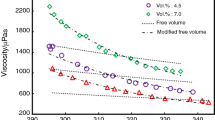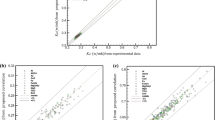Abstract
Viscosity plays a crucial role in the flow and heat transfer process of nanofluids. To effectively calculate and predict the changing characteristics of nanofluids viscosity, this study presents a theoretical model combining the static interface layer and dynamic Brownian motion mechanisms of spherical nanoparticles for water-based Newtonian nanofluids. The model describes the reasonable dependences of nanofluids viscosity on physical properties of nanoparticles (density, volume fraction, size) and base fluid (temperature, viscosity, density). Taking four kinds of typical water-based Newtonian nanofluids containing spherical oxide nanoparticles (Al2O3, CuO, SiO2 and TiO2) as examples, the prediction performance of different viscosity models is analyzed in detail. From the comparison studies, it is demonstrated that the new viscosity model developed in this paper can exhibit better prediction performance than many well-known theoretical models and empirical correlations. Not only do the predicted results of model agree well with the experimental data from various studies, but also the effects of different factors are reflected effectively.









Similar content being viewed by others
References
Choi SUS, Eastman JA (1995) Enhancing thermal conductivity of fluids with nanoparticles. In: IMECE, pp 12–17.
Elsheikh AH, Sharshir SW, Mostafa ME, Essa FA, Ali MKA. Applications of nanofluids in solar energy: a review of recent advances. Renew Sustain Energy Rev. 2017;82(3):3483–502.
Meibodi SS, Kianifar A, Mahian O, Wongwises S. Second law analysis of a nanofluid-based solar collector using experimental data. J Therm Anal Calorim. 2016;126(2):617–25.
Saidur R, Kazi SN, Hossain MS, Rahman MM, Mohammed HA. A review on the performance of nanoparticles suspended with refrigerants and lubricating oils in refrigeration systems. Renew Sustain Energy Rev. 2011;15(1):310–23.
Sidik NAC, Samion S, Ghaderian J, Yazid MNAWM. Recent progress on the application of nanofluids in minimum quantity lubrication machining: a review. Int J Heat Mass Transf. 2017;108:79–89.
Mohammed HA, Bhaskaran G, Shuaib NH, Saidur R. Heat transfer and fluid flow characteristics in microchannels heat exchanger using nanofluids: a review. Renew Sust Energ Rev. 2011;15(3):1502–12.
Sidik NAC, Yazid MNAWM, Mamat R. A review on the application of nanofluids in vehicle engine cooling system. Int Commun Heat Mass. 2015;68:85–90.
Sharma D, Pandey KM, Debbarma A, Choubey G. Numerical investigation of heat transfer enhancement of SiO2-water based nanofluids in light water nuclear reactor. Mater Today. 2017;4(9):10118–22.
Mahbubul IM, Saidur R, Amalina MA. Latest developments on the viscosity of nanofluids. Int J Heat Mass Transf. 2012;55(4):874–85.
Murshed SMS, Estellé P. A state of the art review on viscosity of nanofluids. Renew Sustain Energy Rev. 2017;76:1134–52.
Bashirnezhad K, Bazri S, Safaei MR, Goodarzi M, Dahari M, Mahian O, Dalkılıça AS, Wongwises S. Viscosity of nanofluids: a review of recent experimental studies. Int Commun Heat Mass. 2016;73:114–23.
Putra N, Roetzel W, Das SK. Natural convection of nano-fluids. Heat Mass Transf. 2003;39(8–9):775–84.
Das SK, Putra N, Roetzel W. Pool boiling characteristics of nano-fluids. Int J Heat Mass Transf. 2003;46(5):851–62.
Prasher R, Song D, Wang J, Phelan P. Measurements of nanofluid viscosity and its implications for thermal applications. Appl Phys Lett. 2006;89(13):133108.
Chevalier J, Tillement O, Ayela F. Rheological properties of nanofluids flowing through microchannels. Appl Phys Lett. 2007;91(23):233103.
Lu WQ, Fan QM. Study for the particle’s scale effect on some thermophysical properties of nanofluids by a simplified molecular dynamics method. Eng Anal Bound Elem. 2008;32(4):282–9.
Anoop KB, Sundararajan T, Das SK. Effect of particle size on the convective heat transfer in nanofluid in the developing region. Int J Heat Mass Transf. 2009;52(9–10):2189–95.
Duangthongsuk W, Wongwises S. Measurement of temperature-dependent thermal conductivity and viscosity of TiO2-water nanofluids. Exp Therm Fluid Sci. 2009;33(4):706–14.
Dalkilic AS, Küçükyıldırım BO, Eker AA, Çebi A, Tapan S, Jumpholkul C, Wongwises S. Experimental investigation on the viscosity of Water-CNT and Antifreeze-CNT nanofluids. Int Commun Heat Mass. 2017;80:47–59.
Zadeh AD, Toghraie D. Experimental investigation for developing a new model for the dynamic viscosity of silver/ethylene glycol nanofluid at different temperatures and solid volume fractions. J Therm Anal Calorim. 2018;131(2):1449–61.
Schmidt AJ, Chiesa M, Torchinsky DH, Johnson JA, Boustani A, McKinley GH, Nelson KA, Chen G. Experimental investigation of nanofluid shear and longitudinal viscosities. Appl Phys Lett. 2008;92(24):244107.
Ahammed N, Asirvatham LG, Wongwises S. Effect of volume concentration and temperature on viscosity and surface tension of graphene-water nanofluid for heat transfer applications. J Therm Anal Calorim. 2016;123(2):1399–409.
Nguyen CT, Desgranges F, Roy G, Galanis N, Maré T, Boucher S, Mintsa HA. Temperature and particle-size dependent viscosity data for water-based nanofluids-hysteresis phenomenon. Int J Heat Fluid Flow. 2007;28(6):1492–506.
Anoop KB, Kabelac S, Sundararajan T, Das SK. Rheological and flow characteristics of nanofluids: influence of electroviscous effects and particle agglomeration. J Appl Phys. 2009;106(3):034909.
Turgut A, Tavman I, Chirtoc M, Schuchmann HP, Sauter C, Tavman S. Thermal conductivity and viscosity measurements of water-based TiO2 nanofluids. Int J Thermophys. 2009;30(4):1213–26.
Pastoriza-Gallego MJ, Casanova C, Legido JL, Piñeiro MM. CuO in water nanofluid: influence of particle size and polydispersity on volumetric behaviour and viscosity. Fluid Phase Equilib. 2011;300(1–2):188–96.
Namburu PK, Kulkarni DP, Misra D, Das DK. Viscosity of copper oxide nanoparticles dispersed in ethylene glycol and water mixture. Exp Therm Fluid Sci. 2007;32(2):397–402.
Sundar LS, Sharma KV, Naik MT, Singh MK. Empirical and theoretical correlations on viscosity of nanofluids: a review. Renew Sustain Energy Rev. 2013;25:670–86.
Hemmati SA, Varamesh A, Husein MM, Karan K. On the evaluation of the viscosity of nanofluid systems: modeling and data assessment. Renew Sustain Energy Rev. 2018;81:313–29.
Azmi WH, Sharma KV, Mamat R, Najafi G, Mohamad MS. The enhancement of effective thermal conductivity and effective dynamic viscosity of nanofluids—a review. Renew Sustain Energy Rev. 2016;53:1046–58.
Einstein A. A new determination of molecular dimensions. Ann Phys. 1906;19:289–306.
Brinkman HC. The viscosity of concentrated suspensions and solutions. J Chem Phys. 1952;20(4):571–571.
Batchelor GK. The effect of Brownian motion on the bulk stress in a suspension of spherical particles. J Fluid Mech. 1977;83(1):97–117.
Frankel NA, Acrivos A. On the viscosity of a concentrated suspension of solid spheres. Chem Eng Sci. 1967;22(6):847–53.
Lundgren TS. Slow flow through stationary random beds and suspensions of spheres. J Fluid Mech. 1972;51(2):273–99.
Żyła G. Viscosity and thermal conductivity of MgO-EG nanofluids. J Therm Anal Calorim. 2017;129(1):171–80.
Masoumi N, Sohrabi N, Behzadmehr A. A new model for calculating the effective viscosity of nanofluids. J Phys D Appl Phys. 2009;42(5):055501.
Tseng WJ, Lin KC. Rheology and colloidal structure of aqueous TiO2 nanoparticle suspensions. Mater Sci Eng. 2003;355(1–2):186–92.
Abu-Nada E. Effects of variable viscosity and thermal conductivity of Al2O3-water nanofluid on heat transfer enhancement in natural convection. Int J Heat Fluid Flow. 2009;30(4):679–90.
Khanafer K, Vafai K. A critical synthesis of thermophysical characteristics of nanofluids. Int J Heat Mass Transf. 2011;54(19):4410–28.
Masoud HS, Moghadassi AR, Henneke DE. A new dimensionless group model for determining the viscosity of nanofluids. J Therm Anal Calorim. 2010;100(3):873–7.
Zhao N, Yang J, Li H, Zhang Z, Li S. Numerical investigations of laminar heat transfer and flow performance of Al2O3–water nanofluids in a flat tube. Int J Heat Mass Transf. 2016;92:268–82.
Zhao N, Li S, Yang J. A review on nanofluids: data-driven modeling of thermalphysical properties and the application in automotive radiator. Renew Sust Energ Rev. 2016;66:596–616.
Hatschek E. The general theory of viscosity of two-phase systems. Trans Faraday Soc. 1913;9:80–92.
Maiga SEB, Palm SJ, Nguyen CT, Roy G, Galanis N. Heat transfer enhancement by using nanofluids in forced convection flows. Int J Heat Fluid Flow. 2005;26(4):530–46.
Wang X, Xu X, Choi SUS. Thermal conductivity of nanoparticle-fluid mixture. J Thermophys Heat Transf. 1999;13(4):474–80.
Buongiorno J. Convective transport in nanofluids. J Heat Transf T ASME. 2006;128(3):240–50.
Pak BC, Cho YI. Hydrodynamic and heat transfer study of dispersed fluids with submicron metallic oxide particles. Exp Heat Transf. 1998;11(2):151–70.
Putra N, Roetzel W, Das SK. Natural convection of nanofluids. Heat Mass Transf. 2003;39:775–84.
Palm SJ, Roy G, Nguyen CT. Heat transfer enhancement with the use of nanofluids in radial flow cooling systems considering temperature-dependent properties. Appl Therm Eng. 2006;26(17–18):2209–18.
Murshed SMS, Leong KC, Yang C. A combined model for the effective thermal conductivity of nanofluids. Appl Therm Eng. 2009;29(11–12):2477–83.
Pang C, Jung JY, Kang YT. Aggregation based model for heat conduction mechanism in nanofluids. Int J Heat Mass Transf. 2014;72:392–9.
Hashimoto T, Fujimura M, Kawai H. Domain-boundary structure of styrene-isoprene block copolymer films cast from solutions. 5. Molecular-weight dependence of spherical microdomains. Macromolecules. 1980;13(6):1660–9.
Ferrouillat S, Bontemps A, Ribeiro J, Gruss J, Soriano O. Hydraulic and heat transfer study of SiO2/water nanofluids in horizontal tubes with imposed wall temperature boundary conditions. Int J Heat Fluid Flow. 2011;32:424–39.
Zhao NB, Zheng HT, Yang JL, Yang L. Experimental study on thermal conductivity and viscosity of Al2O3–H2O nanofluids. J Harbin Eng Univ. 2018;39(1):60–6.
Chen H, Ding Y, Tan C. Rheological behaviour of nanofluids. New J Phys. 2007;9(10):1–24.
Kwek D, Crivoi A, Duan F. Effects of temperature and particle size on the thermal property measurements of Al2O3-water nanofluids. J Chem Eng Data. 2010;55(12):5690–5.
Pastoriza-Gallego MJ, Casanova C, Páramo R, Barbés B, Legido JL, Piñeiro MM. A study on stability and thermophysical properties (density and viscosity) of Al2O3 in water nanofluid. J Appl Phys. 2009;106(6):064301.
Tavman I, Turgut A, Chirtoc M, Schuchmann HP, Tavman S. Experimental investigation of viscosity and thermal conductivity of suspensions containing nanosized ceramic particles. Arch Mater Sci Eng. 2008;34(2):99–104.
Pastoriza-Gallego MJ, Casanova C, Legido JL, Pineiro MM. CuO in water nanofluid-influence of particle size and polydispersity on volumetric behaviour and viscosity. Fluid Phase Equilib. 2011;300:188–96.
Pantzali MN, Kanaris AG, Antoniadis KD, Mouza AA, Paras SV. Effect of nanofluids on the performance of a miniature plate heat exchanger with modulated surface. Int J Heat Fluid Flow. 2009;30:691–9.
Azmi WH, Sharma KV, Sarma PK, Mamat R, Najafi G. Heat transfer and friction factor of water based TiO2 and SiO2 nanofluids under turbulent flow in a tube. Int Commun Heat Mass. 2014;59:30–8.
Feng X, Johnson DW. Mass transfer in SiO2 nanofluids: a case against purported nanoparticle convection effects. Int J Heat Mass Transf. 2012;55:3447–53.
Duangthongsuk W, Wongwises S. An experimental study on the heat transfer performance and pressure drop of TiO2-water nanofluids flowing under a turbulent flow regime. Int J Heat Mass Transf. 2010;53:334–44.
Fedele L, Colla L, Bobbo S. Viscosity and thermal conductivity measurements of water-based nanofluids containing titanium oxide nanoparticles. Int J Refrig. 2012;35:1359–66.
Acknowledgements
The authors would like to acknowledge the National Nature Science Foundation of China (51709059), the Province Nature Science Foundation of Heilongjiang (QC2017045) and the Fundamental Research Funds for the Central Universities (HEUCFM180302) for supporting this work.
Author information
Authors and Affiliations
Corresponding author
Rights and permissions
About this article
Cite this article
Yang, J., Zhao, N., Li, Z. et al. A combined theory model for predicting the viscosity of water-based Newtonian nanofluids containing spherical oxide nanoparticles. J Therm Anal Calorim 135, 1311–1321 (2019). https://doi.org/10.1007/s10973-018-7510-6
Received:
Accepted:
Published:
Issue Date:
DOI: https://doi.org/10.1007/s10973-018-7510-6




